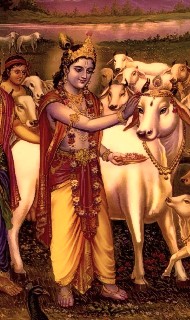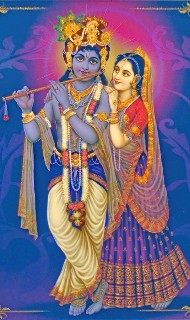
Harinama in Auckland, New Zealand (Album with photos)
Kalasamvara Das: Harinam Sankirtan will never stop,
It is the desire...
Websites from the ISKCON Universe

Harinama in Auckland, New Zealand (Album with photos)
Kalasamvara Das: Harinam Sankirtan will never stop,
It is the desire...
 By Tom Zillich
By Tom Zillich “I went through a lot of pain, physical,” Swami admitted. “The biggest challenge of all is walking on an angle – it’s like walking on a beach. But nevertheless, everything else compensated for that (pain), including meeting fantastic people, meeting characters, being confronted by black bears, grizzlies, whatnot, and finally I became an addict, I like it, gotta do it again.” His first coast-to-coast walk was documented in “The Longest Road,” a 2003 National Film Board of Canada movie about the Trans-Canada Highway. Continue reading "‘The Walking Monk’ in Surrey with tales from cross-Canada trails
→ Dandavats"

Harinam on a bus in Tel Aviv | ISKCON Israel (Album with photos)
Srila Prabhupada: If the surface of the globe is overflooded ...

Since its release in February 2016, the short film celebrating ISKCON's 50th Anniversary has been screened in over fourty countries and seen by hundreds of thousands. Recently, the Russian version has been released. Click here for the English version: https://www.youtube.com/watch?v=44OoZ6GfmK0. For a high definition screening copy please contact Krishna-lila dasi: editor@iskconnews.com

Holy Name Festival in New Vrajamandala, Spain (Album with photos)
Srila Prabhupada: For a transcendental blissful life, chant ...
 By Sri Narayana Rsi
By Sri Narayana Rsi O Narada, after going a short distance they saw the beautiful asrama of Radha, who is the queen of the rasa dance, the queen of the demigods, the best of the gopis, and She who to Lord Krsna is more dear than life, a beautiful, beautiful asrama that was completely indescribable, that no great pandita could describe, that was a great circle of six gavyutis (Note: A gavyuti is equal to two miles) that had a hundred palaces, shone with the splendour of many jewels, was made of the best of the best of priceless jewels, was beautiful with many impassable deep moats, filled with a hundred flower gardens and many kalpa-vrksa trees, constructed with many jewels, surrounded by great walls and was made with jewel benches and seven wonderful jewel gates, O sage, a series of seven gates that led, one after the other, to a place of sixteen gates. Gazing at this great wall as tall as a thousand bows and splendidly beautiful with many small jewel domes, the (three) demigods became filled with wonder. Continue reading "Description of Goloka
→ Dandavats"
Today is the most auspicious appearance day (Vyasapuja) of Srila Gour Govinda Swami. At Mayapur, the disciples and devotees of Mayapur community came together to offer glorification & pushpanjali at his puspha Samadhi mandir. In the morning, video class of Gour Govinda Maharaj was played in the temple hall. Senior devotees, his god brothers & disciples shared […]
The post Srila Gour Govinda Swami Vyasapuja appeared first on Mayapur.com.

Ratha Yatra 2016 in Tenerife, Playa De Las Americas (Album with photos)
Srila Prabhupada: All persons in this material world ar...
 By Brahma-vaivarta Purana
By Brahma-vaivarta Purana Listen and I will tell you of Lord Hari’s descent as a cowherd boy. His arrival in Gokula, and Radha’s descent as gopi. Listen and I will tell you in detail what before you heard me tell only briefly in the story of Sankhacuda’s death. Sridama quarrelled with Radha and She cursed him to become the demon Sankhacuda. Then Sridama cursed Radha: Go to a human womb in Vraja! Become a girl of Vraja and walk on the earth’s surface! Afraid of Sridama’s curse, She went to Sri Krsna and said: I will become a gopi! Sridama cursed Me! What will I do to prevent it! O breaker of fears please tell me. How can I live without You? O Lord, without You every moment will become a hundred yugas. Continue reading "Why Srimati Radharani descended from Goloka?
→ Dandavats"
Being simple hearted like Prahlada Maharaja
The post From Budapest appeared first on SivaramaSwami.com.

Satchitanoya Prabhu and his 92 YEAR-OLD MOTHER walking the ENTIRE Ratha Yatra Parade, from the Santa Monica Civic Center to Venice B...

Huge Janmashtami celebration in the concert hall “Russia” of the Luzhniki Stadium, Moscow, Russia (Album with 120 photos)
Srila Prabhupada: It is the practice of brahmanas conversant with the science to pronounce a Vedic mantra in the right accent. But even if the Hare Krishna mantra is not chanted properly, it still has so much potency that the chanter gains the effect. (Srimad-Bhagavatam, 4.13.27 Purport)
Find them here: https://goo.gl/qBoMO1
The post August31,2016-Daily Darshan appeared first on Mayapur.com.
The post August30.2016-Daily Darshan appeared first on Mayapur.com.
The post August29,2016-Daily Darshan appeared first on Mayapur.com.
The post August 28,2016-Daily Darshan appeared first on Mayapur.com.
The post August 27,2016-Daily Darshan appeared first on Mayapur.com.

The cult of Krishna is growing in officially atheist China.
Hindustantimes.com: Numbers are difficult to compile and often anecdotal in nature, but the philosophy of love and devotion as symbolised by Krishna, one of Hinduism’s popular deities, is evidently attracting many Chinese in urban areas.
Last week, a large number of devotees celebrated Krishna Janmashtami, the day that marks his birth, across China in big and small groups, at yoga centres and among family members.
Celebrations were mostly marked by chanting of “Hare Krishna”, singing devotional songs, readings from the Bhagavad Gita and distribution of sweets including laddoos.
The day was also celebrated in the cities of Beijing, Shanghai, Chengdu, Shenzhen, Harbin and the province of Wuhan. (HT/Sutirtho Patranobis)
One of the larger celebrations was held at the International Buddhist Items and Crafts Fair in Dongguan city in the southern Chinese province of Guangdong. “At the Dongguan fair, we presented the murtis of Jagannath, Balaram and Subhadra as three international angels of auspiciousness and distributed 3,000 packages of sweets,” a devotee who identified himself as Gaudiya Das told HT.
“There were congregational chanting and we took the three murtis on a vehicle around the entire fair, distributing foods like laddoos, chapatis, sweet rice and even (traditional Chinese food) moon cakes,” he said.
The day was also celebrated in the cities of Beijing, Shanghai, Chengdu, Shenzhen, Harbin and the province of Wuhan, said Das, a trained practitioner of Bhakti yoga.
“It is not about any religion. You do not have to believe in Hinduism to celebrate Krishna’s birthday. It is like Christmas: the whole world celebrates, everyone is happy.”
Some of the organisers were from the International Society for Krishna Consciousness (ISKCON) group.
The Chinese like traditional culture and that’s why Krishna and His teachings are gaining in popularity, he added.
To read the entire article click here: http://goo.gl/PRc5jD
Hunger in our mouths
Comes from emptiness in our stomachs.
Hunger in our senses
Comes from emptiness in our hearts.
The mouth can fill a stomach’s emptiness
But can the heart’s emptiness be filled through the senses?
The heart’s emptiness
Is best filled by her close friends: the mind and words.
If you hear the right words
And think about them deeply, feelingly.
You will never again go hungry.
Hear about All-Attractive, All-Delighting Krishna-Rāma.
And contemplate what you hear, deeply… feelingly.
ECO-Vrindaban Board Meeting Minutes 07/24/2016
Mission Statement: ECO-Vrindaban promotes simple living, cow protection, engaging oxen, local agriculture, and above all, loving Krishna, as envisioned by Srila Prabhupada, the Founder-Acharya of ISKCON New Vrindaban.
Participating Directors: Anuttama, Bhima, Chaitanya Mangala, Ranaka and Sri Tulasi Manjari
Advisors: Radha-Krishna, Vraja
Managers: Mukunda, Nitaicandra
1. Mukunda’s Monthly Report
2. Nitaicandra’s Monthly Report
3. Steering Committee Inclusion
The ECO-V Board is in favor of starting to include the Village Association Steering Committee members in the monthly “Joint Board” meetings between ISKCON New Vrindaban and ECO-Vrindaban. Concurrently, the Board requests the Steering Committee to set a date, within a reasonable time frame, for the vote to elect a New Vrindaban Village Council.

Devotees at ISKCON New Vrindaban, West Virginia are in the midst of major renovations on Srila Prabhupada’s Palace. And they’re launching a campaign to help them continue restoring the renowned Smriti Samadhi, or memorial shrine to ISKCON’s Founder-Acharya, to its full glory. The effort is a labor of love, just as it was when devotees first started building the Palace in 1973, intending it as a residence for their guru, who expressed a strong desire to retire there and translate his books.